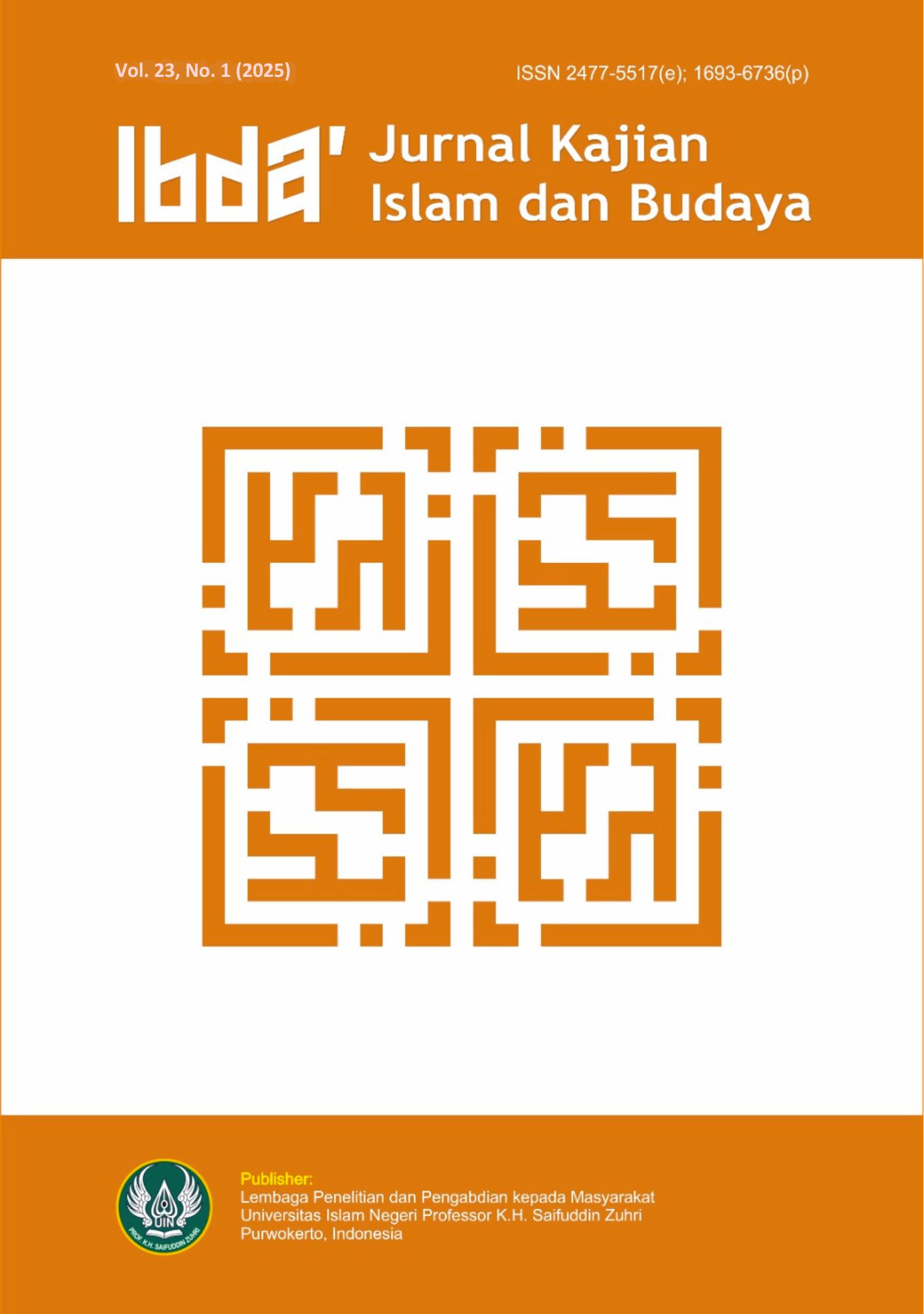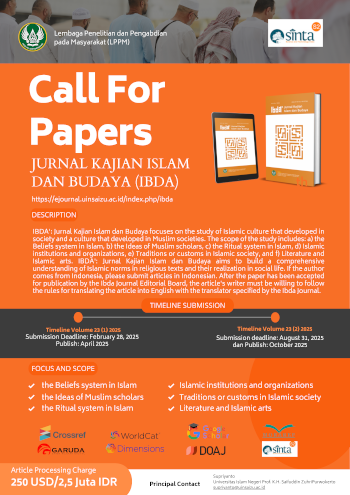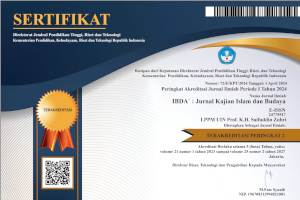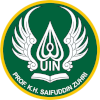Cultural Syncretism and Religious Authority: Early Ramadan Determination Practices in Maluku
DOI:
https://doi.org/10.24090/ibda.v23i1.12973Keywords:
early determination of ramadan, local wisdom, islamic lawAbstract
Identifying the commencement of Ramadan in Indonesia encompasses religious and socio-cultural dimensions, illustrating the intricate interplay between Islamic doctrine and local traditions. This study adopts a qualitative methodology and field research techniques to explore harmonizing these elements in establishing the onset of Ramadan in Maluku. Findings indicate that the Maluku community perceives local customs as an essential aspect that should be integrated into all religious rituals and practices, including the early declaration of Ramadan. The method employed annually to determine Ramadan's beginning is regarded as a legitimate cultural heritage with authenticity and alignment with Islamic principles. In Maluku, religious symbols and traditional practices in observing the new moon via natural indicators are frequently utilized concurrently to ascertain the start of Ramadan. This interplay fosters a symbolic dynamic that merges scientific methodologies with traditional practices, influenced by the roles of national religious bodies and local indigenous communities.Downloads
References
A’mal, F. (2022). Study of Islamic Astronomics: Methods and Criteria of Rukyat Hisab Determining the Beginning of the Month in Libya. Proceeding of International Conference on Sharia and Law, 1(1), 60–64.
Afifi, A. A., & Abbas, A. F. (2022). Moderate Way Implementing Rukyah and Hisab to Determine A New Moon in Ramadan. AL-IMAM: Journal on Islamic Studies, Civilization and Learning Societies, 3(April), 11–18. https://doi.org/1 0.58764/j.i m.2022.3.12
Al-Arouj, M., Assaad-Khalil, S., Buse, J., Fahdil, I., Fahmy, M., Hafez, S., Hassanein, M., Ibrahim, M. A., Kendall, D., Kishawi, S., Al-Madani, A., Nakhi, A. Ben, Tayeb, K., & Thomas, A. (2010). Recommendations for Management of Diabetes During Ramadan.Diabetes Care, 33(8), 1895–1902. https://doi.org/10.2337/dc10-0896
Al-Mostafa, Z. A. (2010). The possibility of seeing two crescent moons in one day and the interpretation of the disappearance of the crescent by Sheikh Al-Islam. Journal of King Saud University-Science, 22(1), 51–55. https://doi.org/10.1016/j.jksus .2009.12.008
Alanuari. (2022). Otoritas Agama dari Akar Rumput Islam Indonesia. Islam Nusantara: Journal for the Study of Islamic History and Culture, 3(1), 93–102. https://doi.org/10.47776/islamnusantara.v3i1.277
Almoharby, D., & Neal, M. (2013). Clarifying Islamic perspectives on leadership. Education, Business, and Society: Contemporary Middle Eastern Issues, 6(3–4), 148–161. https://doi.org/10.1108/EBS-02-2011-0008
Anggraini, N., Zulkifli, & Hakiem, N. (2024). Modeling Ramadan Hilal classification with image processing technology using the Yolo algorithm. Journal of Applied Data Sciences, 5(3), 1462–1471. https://doi.org/10.47738/jads.v5i3.311
Bakibinga-Gaswaga, E. (2021). African Traditional Religion and Law-Intersections between the Islamic and non-Islamic Worlds and the Impact on Development in the 2030 Agenda era. Law and Development Review, 14(1), 1–31. https://doi.org/1 0.1515/ldr-2020-0011
Chakim, S. (2022). A Review of Rituals and Local Wisdom of Indigenous Peoples in Indonesia. IBDA` : Jurnal Kajian Islam Dan Budaya, 20(2), 181–199. https://doi.org/10.24090/ibda.v20i2.6439
Elkabbaj, N., Agoub, M., & Khoubila, A. (2021). Obsessions Religieuses Et Ramadanreligious Obsessions and Ramadan. International Journal of Advanced Research (IJAR), 9(07), 196–202. https://doi.org/10.21474/IJAR01/13117
Frifana, S. O. (2020). Hadis Matla’ Hilal ( Tempat Terbitnya Hilal dan Tempat Terjadinya Hilal ). Jurnal Ilmu Falak Dan Astronomi, 2(1), 15–30.
Gerber, H. (1999).Islamic Law and Culture 1600-1840. Brill.
Hamzah, Z. (2018). Interaction of Islam with Local Culture. AJIS: Academic Journal of Islamic Studies, 3(1), 1. https://doi.org/10.29240/ajis.v3i1.482
Hanip, A. (2023). Penentuan Awal dan Akhir Bulan Ramadhan dengan Metode Hisab “Urf Khomasi” di Pesantren Nahfiludduror Jember. Jurnal Asa/ Jurnal Kajian Hukum Islam, 5(1), 14–30.
Hasan, M. (2023). The Interaction of Fiqh and Science in Determining the Beginning of the Hijri Month in Indonesia.Journal of Islamic Law, 4(2), 237–257. https://doi.org/10.24260/jil.v4i2.1433
Hasan, N., & Susanto, E. (2019). Relasi Agama dan Tradisi Lokal (Studi Fenomonologis Tradisi Dhamong di Madura). CV Jakad Media Publishing.
Indrawan, J., & Putri, A. T. (2022). Analisis Konflik Ambon Menggunakan Penahapan Konflik Simon Fisher. Jurnal Kolaborasi Resolusi Konflik, 4(1), 12. https://doi.org/10.24198/jkrk.v4i1.36608
Ismail, & Ghofur, A. (2019). Implementasi Maqashid Syariah dalam Sidang Itsbat Hilal Penentuan Awal Ramadan. International Journal Ihya’ ’Ulum Al-Din, 21(1), 80–94. https://doi.org/10.21580/ihyaa.21.1.4163
Izzuddin, A., Budiwati, A., & Zubaidah, S. (2021). Implementation of Unity of Science on Ilm Falak’s (Islamic Astronomy) Curricula. Proceedings of the 2nd Southeast Asian Academic Forum on Sustainable Development (SEA-AFSID 2018), 168, 236–241.
Jenuri, Zainuddin, Z., Mutholib, A., Ramdhani, R., & Octafiona, E. (2024). Dinamika Sosial Masyarakat Muslim : Studi Kasus tentang Interaksi antara Agama dan Budaya Lokal di Indonesia Social Dynamics in Muslim Societies : Case Studies on the Interaction between Religion and Local Culture in Indonesia. Jurnal Kalaboratif Sains, 7(5), 1777–1787. https://doi.org/10.56338/jks.v7i5.5358
Khalik, A. T. (2017). Kearifan T Migou P W Ang Pa. Ibda’ Jurnal Kebudayaan Islam, 15(1), 76–95.
Koto, I., Hati, L. P., Manurung, A. S., & Siregar, A. S. (2024). Islamic Holy Days : The Contention of Rukyatul Hillal and Hisab Hakiki Wujudul Hilal Disputes for Muslims in Indonesia. Pharos Journal of Theology, 105(2), 1–14.
Laili, N., Nazahah, N., & Salamah, U. (2022). Tradisi Penetapan 1 Ramadhan dengan Penanggalan Jawa : Kajian Living Hadis atas Komunitas Islam Aboge di Desa Cikakak , Kecamatan Wangon , Kabupaten Banyumas. Al-Kawakib, 3(2), 139–151.
Leirissa, R. Z., Ohorella, G. ., & Latuconsina, D. (1999). Sejarah Kebudayaan Maluku. CV. Ilham Bangun Karya.
Lussier, D. N., & Ahnaf, M. I. (2024). Neutralizing the sacred space : pre-election messages in a typical Indonesian city. Cambridge University Press, 17, 341–361. https://doi.org/10.1017/S1755048324000117
Mahasena, P., Yusuf, M., Irfan, M., Akbar, E. I., Jatmiko, A. T. P., Mandey, D., Setiawan, A., Sulaeman, M., Hidayat, T., Herdiwijaya, D., Raharto, M., & Dermawan, B. (2019). CCD observation of daylight crescent moon at Bosscha observatory. Journal of Physics: Conference Series, 1127(1). https://doi.org/10.1088/1742-6596/1127/1/012049
Majid, A., Saghirah, S., Wendry, N., Safri, E., & Syarifuddin, S. (2023). The Method in Understanding Hadith Through Ijmā’ and Its Implications for Islamic Law in Indonesia: Studies on the Hadiths of the Month of Qamariyah. Samarah: Jurnal Hukum Keluarga Dan Hukum Islam, 7(1), 281–301. https://doi.org/10.22373/sjhk.v7i1.12383
Maskufa. (2018). Global Hijriyah Calendar as Challenges Fikih Astronomy. Advances in Social Science, Education, and Humanities Research, 162(Iclj, 2017), 188–192.
Muhammadong, NurHilaliyah, & Khaerunnisa. (2024). Dynamics of Implementing Islamic Law Through the Islamic Sharia Enforcement Committee in South Sulawesi. Letters in High Energy Physics, 2024, 205–211.
Musonnif, A. (2021). In Search of The Moon: The Hisab, Ru’yah, and Kashf. Epistemé Jurnal Pengembangan Ilmu Keislaman, 16(December), 105–125. https://doi.org/10. 21274/epis.2021.16.2.105-125
Nur, E. R. (2020). Transformation of Islamic Values in the Development of the National Legal System. Proceedings of the 1st Raden Intan International Conference on Muslim Societies and Social Sciences (RIICMuSSS, 2019), 492(RIICMuSSS, 2019), 185–189. https://doi.org/10.2991/assehr.k.201113.035
Nursodik, & Djamaluddin, T. (2023). Applicability of the New MABIMS Criteria and Its Impact in the Southeast Asia Region. Proceeding of International Conference on Sharia and Law (ICOSLAW) 2023 Social and Digital Sphere: The Development of Sharia and Law on Humanity, 2(01).
Oppong, S. H. (2013). Religion and Identity. American International Journal of Contemporary Research Religion, 3(6), 10–16.
Pathak, M. (2005). Tribal Customs Law and Justice (Second Edi). A Mittal Publication.
Putri, H. T., & Qodir, I. (2022). Aceh Local Wisdom in The Method of Determining The Hijri Calendar. Al-Hilal: Journal of Islamic Astronomy, 4(1), 1–16.
Rashed, M. G., & Moklof, M. G. (2017). The suggestion of a conventional Islamic calendar.NRIAG Journal of Astronomy and Geophysics, 6(2), 275–277. https://doi.org/10.1016 /j.nrjag.2017.06.004
Rashed, M. G., Moklof, M. G., Hamza, A. E., Rashed, M. G., Moklof, M. G., & Hamza, A. E. (2019). Investigation of the Arithmetical or Tabular Islamic calendar.NRIAG Journal of Astronomy and Geophysics, 7(1), 20–21. https://doi.org/10.1016/j.nrjag .2017.12.005
Rasyidin, R., & Ismail, I. (2019). Telaah Kritis Metode Hisab Penentuan Awal Ramadhan Pengikut Habib Seunagan Nagan Raya-Aceh. Jurisprudensi: Jurnal Ilmu Syariah, Perundang-Undangan, Ekonomi Islam, 11(2), 164–183. https://doi.org/10.32505/ jurisprudensi.v11i2.1076
Ridho, A. (2019). Tradisi megengan dalam menyambut Ramadhan: Living Qur’an sebagai kearifan lokal menyemai Islam di Jawa. Jurnal Literasiologi, 1(2 Juli-Desember2019), 24–50. https://jurnal.literasikitaindonesia.com/index.php/literasiologi/article/download/32/44/134
Ridwan, R., & Zain, M. F. (2020). The religious symbol determining the beginning and end of Ramadan in Indonesia. HTS Teologiese Studies/Theological Studies, 1–9.
Rofiuddin, A. A. (2019). Dinamika Sosial Penentuan Awal Bulan Hijriah di Indonesia. Istinbath, 18(2), 233–254. http://www.istinbath.or.id
Royyani, M. A., Mufid, A., Ni’am, M. I., Azizi, A. Q., & Abidin, A. A. (2021). Shahadah ’ Ilmy ; Integrating Fiqh and Astronomy Paradigm in Determining The Arrival of Lunar Months in Indonesia. Al-Ihkam: Jurnal Hukum Dan Pranata Sosial, 16(2), 503–524.
Salim, A., Ridwan, R., & Aziz, J. A. (2024). Whusul Ilallah As a Methodology for Determining the Beginning of Ramadan and The End of Ramadan of The Aolian Jamaat According to The Perspective of Islamic Law. Journal Transnational Universal Studies, 3(5), 253–264. https://doi.org/10.58631/jtus.v3i5.95
Sarjana, S. A., & Kamaluddin Suratman, I. (2018). Konsep ‘Urf dalam Penetapan Hukum Islam. Tsaqafah, 13(2), 279. https://doi.org/10.21111/tsaqafah.v13i2.1509
Setiyawan, A. (2012). Budaya lokal dalam perspektif agama: Legitimasi Hukum Adat (‘Urf ) dalam Islam. Esensia, XIII(Humaniora), 1–20.
Silfiah, R. I. (2020). Kontribusi Hukum Islam Dalam Membangun Hukum Nasional Berwawasan Multikultural. Arena Hukum, 13(01), 77–96. https://doi.org/1 0.21776/ub.arenahukum.2020.01301.5
Sudirman, Long, A. S., & Jubba, H. (2022). Accommodation of Customs and Islamic Laws in Determining the Beginning of the Month of Ramadan for Indigenous Papuan Muslim Community in West Papua. Jurnal Ilmiah Al-Syir’ah, 20(2), 190–205.
Suleman, F., & Usup, D. (2021). The Role of Modern Observation in Understanding the Beginning of the Hijri Month. Al-Syir’ah, 19(1), 106–121. http://journal.iain-manado.ac.id/index.php/JIS/article/view/1128
Taher, P., & Handayani, D. (2018). Hukum Islam. Sinar Grafika.
Tarihoran, A. S. (2015). “Meliek Bulan” Sebuah Tradisi Lokal Pengikut Tarekat Syattariyah di Koto Tuo Agam. Islam Reality: Journal of Islamic & Social Studies, 12(1), 35–44.
Thompson, E. . (1992).Customs in Common: Studies in Traditional Popular Culture. The New Press.
Wahidi, A., Yasin, N., & Kadarisman, A. (2019). The Beginning of Islamic Months Determination in Indonesia and Malaysia: Procedure and Social Condition. ULUL ALBAB Jurnal Studi Islam, 20(2), 322–345. https://doi.org/10.18860/ua.v20i2.5913
Wahidi, A., Yasin, N., Kadir, A., Rouf, A., & Haq, S. (2021). Implementing the Mabims Criteria in Determining the Beginning of Islamic Month in Indonesia and Brunei Darussalam. Proceedings of the International Conference on Engineering, Technology and Social Science (ICONETOS 2020) Implementation, 529(Iconetos, 2020), 96–108.
Wahyuningsih, I., Febriyanti, F., & Rizki, I. A. (2023). Differences in Determining Ramadan and Shawwal: A Discourse Analysis of The Book Nu ṣūṣ Al-Akhy ā r. Ulul Albab: Jurnal Studi Dan Penelitian Hukum Islam, 6(2), 2597–6168.
Wardhani, L. T. A. L., Noho, M. D. H., & Natalis, A. (2022). The adoption of various legal systems in Indonesia: an effort to initiate the prismatic Mixed Legal Systems. Cogent Social Sciences, 8(1), 1–21. https://doi.org/10.1080/23311886.2022.2104710
Yusuf, M., Sahudi, S., Sileuw, M., & Safitri, L. (2021). Menata Kontestasi Simbol-Simbol Keagamaan di Ruang Publik Kota Jayapura. Religious: Jurnal Studi Agama-Agama Dan Lintas Budaya, 7249, 162–174.
Zufriani, Asa’ari, Mirdad, J., Arzam, Izuddin, A., & Radiamoda, A. M. (2023). Rukyat as Determination of the Lunar Month Beginning: A Method, Obstacles, and Debate in Indonesia. Juris: Jurnal Ilmiah Syariah, 22(1), 53–67. https://doi.org/10.319 58/Juris.v22i1.6570
Downloads
Published
How to Cite
Issue
Section
License
Copyright (c) 2025 Marifat Kilwakit, Arif Zamhari

This work is licensed under a Creative Commons Attribution-ShareAlike 4.0 International License.
Authors who publish with this journal agree to the following terms:
- Authors retain copyright and grant the journal right of first publication with the work simultaneously licensed under a Creative Commons Attribution-ShareAlike License a that allows others to share the work with an acknowledgement of the work's authorship and initial publication in this journal.
- Authors are able to enter into separate, additional contractual arrangements for the non-exclusive distribution of the journal's published version of the work (e.g., post it to an institutional repository or publish it in a book), with an acknowledgment of its initial publication in this journal.
- Authors are permitted and encouraged to post their work online (e.g., in institutional repositories or on their website) before and during the submission process, as it can lead to productive exchanges, as well as earlier and greater citation of published work (See The Effect of Open Access).
















